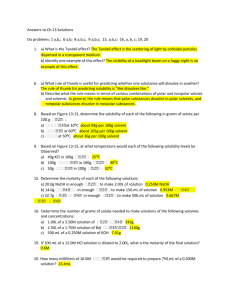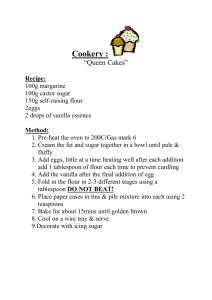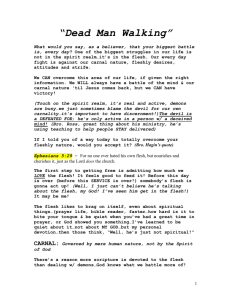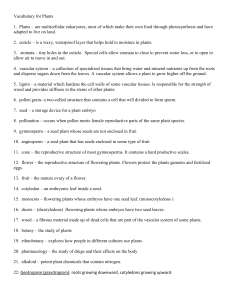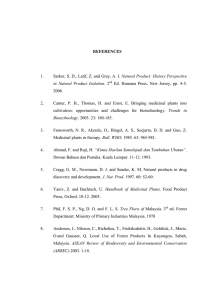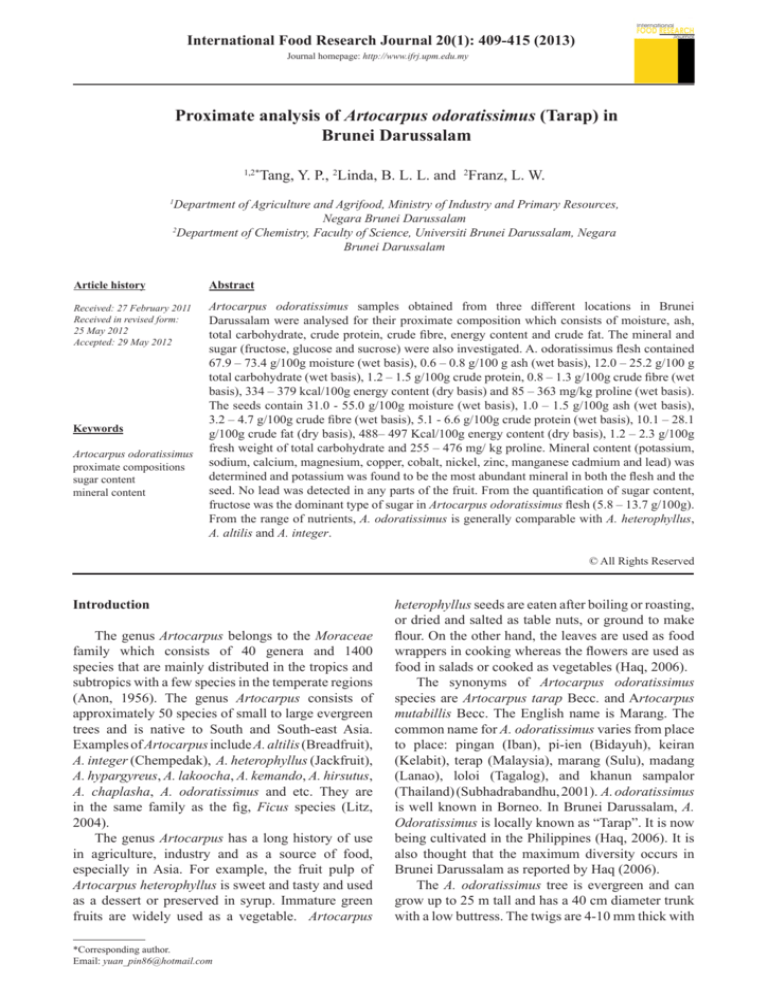
International Food Research Journal 20(1): 409-415 (2013)
Journal homepage: http://www.ifrj.upm.edu.my
Proximate analysis of Artocarpus odoratissimus (Tarap) in
Brunei Darussalam
1,2*
Tang, Y. P., 2Linda, B. L. L. and 2Franz, L. W.
Department of Agriculture and Agrifood, Ministry of Industry and Primary Resources,
Negara Brunei Darussalam
2
Department of Chemistry, Faculty of Science, Universiti Brunei Darussalam, Negara
Brunei Darussalam
1
Article history
Abstract
Received: 27 February 2011
Received in revised form:
25 May 2012
Accepted: 29 May 2012
Artocarpus odoratissimus samples obtained from three different locations in Brunei
Darussalam were analysed for their proximate composition which consists of moisture, ash,
total carbohydrate, crude protein, crude fibre, energy content and crude fat. The mineral and
sugar (fructose, glucose and sucrose) were also investigated. A. odoratissimus flesh contained
67.9 – 73.4 g/100g moisture (wet basis), 0.6 – 0.8 g/100 g ash (wet basis), 12.0 – 25.2 g/100 g
total carbohydrate (wet basis), 1.2 – 1.5 g/100g crude protein, 0.8 – 1.3 g/100g crude fibre (wet
basis), 334 – 379 kcal/100g energy content (dry basis) and 85 – 363 mg/kg proline (wet basis).
The seeds contain 31.0 - 55.0 g/100g moisture (wet basis), 1.0 – 1.5 g/100g ash (wet basis),
3.2 – 4.7 g/100g crude fibre (wet basis), 5.1 - 6.6 g/100g crude protein (wet basis), 10.1 – 28.1
g/100g crude fat (dry basis), 488– 497 Kcal/100g energy content (dry basis), 1.2 – 2.3 g/100g
fresh weight of total carbohydrate and 255 – 476 mg/ kg proline. Mineral content (potassium,
sodium, calcium, magnesium, copper, cobalt, nickel, zinc, manganese cadmium and lead) was
determined and potassium was found to be the most abundant mineral in both the flesh and the
seed. No lead was detected in any parts of the fruit. From the quantification of sugar content,
fructose was the dominant type of sugar in Artocarpus odoratissimus flesh (5.8 – 13.7 g/100g).
From the range of nutrients, A. odoratissimus is generally comparable with A. heterophyllus,
A. altilis and A. integer.
Keywords
Artocarpus odoratissimus
proximate compositions
sugar content
mineral content
© All Rights Reserved
Introduction
The genus Artocarpus belongs to the Moraceae
family which consists of 40 genera and 1400
species that are mainly distributed in the tropics and
subtropics with a few species in the temperate regions
(Anon, 1956). The genus Artocarpus consists of
approximately 50 species of small to large evergreen
trees and is native to South and South-east Asia.
Examples of Artocarpus include A. altilis (Breadfruit),
A. integer (Chempedak), A. heterophyllus (Jackfruit),
A. hypargyreus, A. lakoocha, A. kemando, A. hirsutus,
A. chaplasha, A. odoratissimus and etc. They are
in the same family as the fig, Ficus species (Litz,
2004).
The genus Artocarpus has a long history of use
in agriculture, industry and as a source of food,
especially in Asia. For example, the fruit pulp of
Artocarpus heterophyllus is sweet and tasty and used
as a dessert or preserved in syrup. Immature green
fruits are widely used as a vegetable. Artocarpus
*Corresponding author.
Email: yuan_pin86@hotmail.com
heterophyllus seeds are eaten after boiling or roasting,
or dried and salted as table nuts, or ground to make
flour. On the other hand, the leaves are used as food
wrappers in cooking whereas the flowers are used as
food in salads or cooked as vegetables (Haq, 2006).
The synonyms of Artocarpus odoratissimus
species are Artocarpus tarap Becc. and Artocarpus
mutabillis Becc. The English name is Marang. The
common name for A. odoratissimus varies from place
to place: pingan (Iban), pi-ien (Bidayuh), keiran
(Kelabit), terap (Malaysia), marang (Sulu), madang
(Lanao), loloi (Tagalog), and khanun sampalor
(Thailand) (Subhadrabandhu, 2001). A. odoratissimus
is well known in Borneo. In Brunei Darussalam, A.
Odoratissimus is locally known as “Tarap”. It is now
being cultivated in the Philippines (Haq, 2006). It is
also thought that the maximum diversity occurs in
Brunei Darussalam as reported by Haq (2006).
The A. odoratissimus tree is evergreen and can
grow up to 25 m tall and has a 40 cm diameter trunk
with a low buttress. The twigs are 4-10 mm thick with
Tang et al./IFRJ 20(1): 409-415
410
Determination of moisture content
Whole (intact) A. odoratissimus seeds were dried
at 45°C for seven weeks. A. odoratissimus flesh was
dried using a freeze dryer. The dried seeds and flesh
were transferred into sample bottles and kept in
desiccator until further analysis.
(a) Outer appearance
(b) inner appearance
(c) inner appearance (close up)
Figure 1. Outer and inner appearance of Artocarpus odoratissimus
long yellow to red hair. The fruit is large, averaging
about 16 cm in length, 13 cm in diameter and weighs
about 1 kg. The fruits are roundish oblong, regular and
thickly studded with short, brittle, greenish yellow
spines. The flesh is juicy and aromatic (Coronel,
1983). Galang (1955) described the flesh as clinging
to the central core and each segment of the flesh
contains a seed which has a size of 8 x 15 mm. Galang
(1955) also reported the nutritional composition of A.
odoratissimus in 1955 whereas Fadzelly et al. (2010)
studied the cytotoxicity and polyphenol diversity in
selected parts of A. odoratissimus.
The young fruits are relished as unique vegetables
usually stewed with meat or cooked with spices and
coconut milk. Since fresh vegetables are not readily
available for the tribal people living in the interior
of Borneo, the fruit forms the staple vegetable
diet for them. The fruit is eaten raw and the seeds
are also edible when boiled or roasted. The flesh
is commonly mixed with flour and egg batter and
fried as tarap fritters, used to flavour ice-cream, and
can be fermented to organic vinegar. Studies on the
nutritional composition of A.odoratissimus (Galang,
1955), the phytochemicals and antioxidant activity
of different parts of A.odoratissimus (Bakar et al.,
2009) and the cytotoxicity and polyphenol diversity
in selected parts of A. odoratissimus fruits (Fadzelly
et al., 2010) have been reported.
Materials and Methods
Samples preparation and storage
Seventeen fruits of Artocarpus odoratissimus
(Tarap) were bought from the market located in
Brunei Darussalam. The fruits were separated into
the flesh, seed, core and skin respectively. However,
only the edible portions of the fruits were analysed.
The samples were extracted using the AOAC Official
method 920.149 with slight modification (Cunniff,
1998). All fresh flesh and seed samples were blended
for about 2 min with doubly distilled water (100 mL)
at room temperature and gravity filtered. The filtrate
was then stored in the freezer prior to analysis.
Determination of ash content
Fresh samples were placed in the GALLENKAMP
muffle furnace and ignited to 600˚C for about 4 to 6 h
until residue has turned white. The ash was then used
for the determination of mineral content.
Determination of total carbohydrate
The phenol-sulfuric acid method (AOAC
Method 44.1.30), as stated in the Food Analysis
Laboratory Manual (Nielsen, 2003) with slight
modifications, was used for the determination of the
total carbohydrate content. A series of 6 calibration
standard solutions was prepared from the glucose
stock solution with the concentration ranging from 0
µg/2mL to 100 µg/2mL. The blended sample extracts
(1 mL) prepared in Section 2.1 was further diluted in a
100 mL volumetric flask using doubly distilled water.
This diluted sample (1.0 mL) was then transferred
into a clean conical flask followed by the addition of
doubly distilled water (1.0 mL). Analysis was done
in duplicate. The 80 % phenol solution (50 µL) was
added to each of the standards and sample solutions
and swirled to mix well.
Concentrated sulfuric acid (5 mL) was carefully
added at a constant rate. In order to obtain good and
consistent mixing, the stream of acid was added
directly to the solution mixture without touching
the side of the flask. The solutions were then left to
cool to room temperature. The absorbance of each of
the solutions was then measured using a Shidmadzu
UV-1601PC UV spectrophotometer at wavelengths
between 450-550 nm. The standard solution with 0
µg/2mL water was used as reference. The absorbance
for each of the standard and sample solutions was
recorded at 490 nm.
Determination of mono- and disaccharides by highperformance liquid chromatography (HPLC)
The mono- and disaccharide content (glucose,
fructose and sucrose) in the fresh A. odoratissimus
flesh of each sample was determined using HPLCRID.
Determination of sucrose content
The mobile phase for the determination of the
sucrose content was 75% acetonitrile (HPLC grade)
and 25% ultra-pure water. Sucrose (2.0078 g) was
dissolved in ultra-pure water (100 mL). A series of
Tang et al./IFRJ 20(1): 409-415
5 calibration standard solutions was then prepared
using this solution with concentrations of 0.002,
0.004, 0.006, 0.008 and 0.010 g/mL respectively.
The standard solutions were injected into the HPLC
system and the peak height at about 8.2 min on the
chromatogram was used to plot the calibration curve.
Glucose (6.4 min) and fructose peaks (6 min) were
also detected but the two peaks overlapped each
other. The blended sample solutions were directly
injected into the HPLC system and the peak height
for each sample solution at the same retention time in
as sucrose was recorded.
Determination of glucose and fructose content
Due to the overlap of the fructose and glucose
peaks when the acetonitrile: ultrapure water (3:1)
mobile phase was used, a mobile phase of different
composition was prepared. To enable the separation
of fructose and glucose, the mobile phase was
changed to acetonitrile: ultra-pure water (17:3). A
stock solution containing fructose (1.4988 g) and
glucose (1.5004 g) in a 100 mL was prepared. A series
of 5 calibration standard solutions was then prepared
with concentrations of 0.0015, 0.003, 0.0045, 0.006
and 0.0075 g/mL respectively. The standard solutions
were then injected into the HPLC system and the peak
heights at about 8.5 min and 10 min were used to plot
the calibration curves for fructose and glucose content
respectively. With this mobile phase, the sucrose peak
appeared after 12 min. The blended sample solutions
were directly injected into the HPLC system and the
peak heights were recorded.
Determination of protein
Crude protein was determined using the block
digestion method with a selenium catalyst and the
resulting mixture was allow to steam distill into boric
acid (Kjeldahl Method) (Cunniff, 1998; Madamba,
2000; Nielsen, 2003). Protein content in both flesh and
seed samples was determined using a GERHARDT
automated digestion system and distillation system.
Determination of crude fibre
Crude fibre was determined by the Weendee
Method (Nielsen, 2003) using the principle that
crude fibre is the loss on ignition of the dried residue
remaining after digestion of the sample with 1.25%
(w/v) sulfuric acid and 1.25% (w/v) sodium hydroxide
solutions.
Determination of proline
The method is based on the original method
of Ough (Ough, 1969) which was extracted from
the paper by Bogdanov (Bogdanov). The blended
411
sample extract were used for the determination. The
absorbances were measured using the Shidmadzu UV1601PC UV/VIS spectrophotometer at wavelengths
between 400 and 800 nm. The absorbance at 510
nm was recorded for each of the tubes. The proline
content was determined from the ratio of the sample
solution and the proline standard solution at the
wavelength of 510 nm.
Determination of fat content and the fatty acid
profile
The fat contents in A. odoratissimus seed was
determined using the Soxhlet Method (Nielsen,
2003). The seed were either ground or cut into four
pieces. Dried A. odoratissimus seed (6.0 to 15.0 g)
was placed into a preweighed cellulose extraction
thimble and reweighed. n-Hexane (150 mL) was
poured into a preweighed 500 mL round bottom flask
containing some boiling chips. The soxhlet extraction
was carried out for at least 6 hours. The n-hexane was
then removed by rotary evaporator and the weight of
the crude fat was determined.
The fatty acid content in A. odoratissimus seed
was determined using the AOAC Official Method
969.33 (Cunniff, 1998) with a slight modification.
99.5% methanol was prepared by mixing absolute
methanol (99.5 mL) and distilled water (0.5 mL).
Methanolic sodium hydroxide was prepared by
dissolving sodium hydroxide pellets (2.0834 g) in
the 99.5% methanol. Methanolic sodium hydroxide
(4 mL) was added to the total fat obtained in Section
2.10. and mixture was refluxed for 10 min. Boron
trifluoride (5 mL) was then added to the flask and
refluxed for an additional 2 min. Heptane (3 mL) was
added slowly to the boiling mixture and the mixture
was then cooled to room temperature. Saturated
sodium chloride (25 mL) was added, resulting in the
formation of two layers. The layers were separated
and the top layer was taken and transferred to a clean
preweighed sample vial. The vial was then reweighed.
Anhydrous magnesium sulfate was added. The fattyacid methyl ester (FAME) profile was analysed using
a Shidmadzu GCMS-QP 2010 gas chromatographmass spectrometer (GC-MS).
Determination of energy
The calorific content was determined using a
GALLENKAMP Autobomb bomb calorimeter.
Benzoic acid (about 1.2 g) was first combusted to
determine the heat capacity of the calorimeter. This
was then followed by the combustion of the dried
sample (about 1.2 g).
Determination of minerals
412
Tang et al./IFRJ 20(1): 409-415
The determination was carried out in duplicate.
The ash obtained in Section 2.3 was dissolved in
concentrated hydrochloric acid (2.5 mL) followed by
concentrated nitric acid (2.5 mL). The mixture was
then left at room temperature until all the ash had
dissolved. Each replicate mixture was diluted to 50
mL using ultrapure water respectively. The solutions
were kept in the refrigerator until further analysis
using Shidmadzu AA-6701F atomic absorption
spectrometer.
Result and Discussion
A total of seventeen samples of A. odoratissimus
were analysed. These samples were bought from
various markets throughout Brunei Darussalam i.e.
the Brunei-Muara (n = 4), Temburong (n = 5) and
Tutong Districts (n = 8). The fruit is made up of the
skin, flesh, core and seed. The fruits were weighed
before they were separated into the flesh, seed, core
and skin respectively. Figure shows the outer and
inner appearance of A. odoratissimus.
The fruit of A. odoratissimus is greenish yellow
weighing about 0.5 - 1 kg depending on its size. It is
roundish elliptical, regular and thickly studded with
short, brittle, greenish yellow spines. The number of
edible seeds varies greatly, averaging close to 100.
The seed is ellipsoid about 1 cm x 0.8 cm. Figure
2 shows the percentage mass composition for each
part of the fruit. The skin is the major part of the fruit
followed by the flesh, core and the seed. No mass
composition has been reported previously either for
A. odoratissimus or the other Artocarpus species
except for the edible portion. The edible portion of
A. odoratissimus falls within the data reported by
Galang (1955) (24 – 33%). The edible portion of
jackfruit and chempedak (A. heterophyllus and A.
integer) was reported by Morton (Morton,1987) to be
28% and 22% respectively. These three Artocarpus
species have a similar mass composition for the
edible portion, the flesh.
The moisture content of A. odoratissimus flesh
was found to be between 67.9 to 73.4%. These values
are within the range reported by Galang (1955) (65.784.2%) in 1955. In A. odoratissimus flesh, there was
no observable trend that could be used to relate the
moisture content with the size of the sample. The
moisture content of A. odoratissimus seed was found
to be in the range 31.1 to 54.5%. No previous value
was found for the moisture content in the seed. The
moisture content in jackfruit and chempedak flesh
reported by Morton (Morton,1987) was 83 % and
67 %, while the moisture content of breadfruit as
reported by Badrie (Badrie and Broomes, 2010) was
Figure 2. Mass composition of A.odoratissimus
Table 1. Minerals in A. odoratissimus flesh and seed
Mineral
Potassium
Magnesium
Sodium
Calcium
Iron
Nickel
Cobalt
Manganese
Copper
Zinc
Cadmium
Flesh (mg/100g)
176 – 298
15 - 31
1.1 – 1.7
0.5 -1.4
0.3 -0.5
0.01 - 0.06
0.11 – 0.26
0.02 – 0.93
0.39 – 0.67
0.17 – 0.45
0.0104 - 0.0149
Seed (mg/100g)
352 – 443
103 – 132
0.9 – 3.8
1.5 - 3.0
0.8 – 1.2
0.13 -0.29
0.10 - 0.15
0.27 - 8.64
0.58 - 0.83
0.71 - 1.83
0.0125 - 0.0172
63.8 – 74.3%. Moreover, pedalai (A. sericicarpus)
and selangking (A. nitidus) have 69.3% and 80.8%
moisture content respectively (Voon and Kueh,
1999). Thus A. odoratissimus has similar moisture
content to chempedak, breadfruit and pedalai.
Ash represents the total mineral content in foods.
In 100 g of fresh A. odoratissimus flesh, and seed,
the ash content ranges from 0.6 - 0.8 g and 1.0 - 1.5
g respectively. The values reported Galang (Galang,
1955) was 0.5 - 0.8 g per 100 g fresh sample. The
flesh has less ash than the seed. The ash content in
jackfruit and chempedak flesh reported by Morton
(Morton,1987) was 2.2 % and 1.2, while pedalai
and selangking have 1.7% and 0.7% ash content
respectively (Voon and Kueh, 1999). A. odoratissimus
has a similar ash content to selangking and a lower
ash content the other Artocarpus species. This implies
that A. odoratissimus has less minerals than jackfruit,
chempedak and pedalai.
The total carbohydrate content in the flesh and
seed ranged from 12.0 to 25.2 g/100g sample and 1.2
to 2.3 g/100g sample respectively. The carbohydrate
content for the flesh was reported as 32.4% by Galang
(1955). The value obtained experimentally is however
lower than this. The flesh has dramatically more
carbohydrates than the seeds. The values reported for
jackfruit and chempedak by Morton (Morton,1987)
were 25.4 and 25.8 g/100g fresh sample, while the
carbohydrate content of breadfruit reported by Badrie
(Badrie and Broomes, 2010) was 22.8 – 77.3 g/100g
fresh sample. The carbohydrate contents of these
Artocarpus species are similar to A. odoratissimus.
413
Tang et al./IFRJ 20(1): 409-415
Table 2. Proximate composition in A. odoratissimus flesh together with values obtained from other Artocarpus species
Nutrient
per 100 g
Moisture (%)
Ash (g)
Carbohydrate (g)
Protein (g)
Fibre (g)
Fat (g)
Energy (kcal)
K (mg/100g)
Na (mg/100g)
Ca (mg/100g)
Mg (mg/100g)
Fe (mg/100g)
Mn (mg/100g)
Cu (mg/100g)
Zn (mg/100g)
Cd (mg/100g)
Reported value (wet basis)
Tarap
Breadfruit
67.9 – 73.4
65.7 – 84.2
63.8 - 74.3
0.6 – 0.8
0.5 – 0.8
12.0 – 25.2
32.4
22.8 - 77.3
1.31 – 1.51
0.8 – 1.5
0.7 - 3.8
0.90 – 1.13
0.6 – 0.77
0.2 – 0.3
0.26 - 2.36
90.7 – 100.6 63 - 122
176 -298
352
1.15 – 1.70
7.1
0.48 – 1.35
17
15.2 - 31.1
14.8 – 31.3
0.29 – 0.53
21
0.29-1.4
0.02 – 0.93
0.39 – 0.59
0.17 – 0.45
0.0104
– 0.0149
Tarap
Jackfruit
83
2.2
25.4
1.8
5.6
0.2
301
292
48
37
1.7
-
Chempedak3
67
1.2
25.8
2.5
3.4
0.4
490
246
25
40
1.1
-
Pedalai
69.3
1.7
27.4
1.7
0.5
0.3
119
322
22
25
0.8
1
2.5
7.4
-
Selanking 4
80.8
0.7
14.0
1.7
1.2
1.6
77
164
29
12
0.6
3
1.7
2.3
-
Note: The experimental energy, protein, fibre have been converted to wet basis
Galang, F. G. Fruit and nut growing in the Philippines (AIA Printing Press, Malabon, Rizal, the Philippines, 1955).
Badrie, N. & Broomes, J. (eds. Watson, R. R. & Preedy, V. R.) 491-505 (Academic Press, San Diego, 2010).
Morton, J. F. Fruits of Warm Climates (Miami. Florida).
Voon, B. H. & Kueh, H. S. The nutritional value of indigenous fruits and vegetables in Sarawak. Asia Pacific Clinical Nutrition Society 8, 24-31 (1999).
The fructose, glucose and sucrose contents in A.
odoratissimus flesh ranged from 6.9 – 13.7 g/100g,
5.8 – 13.7 g/100g and 0.3 - 11.2 g/100g respectively.
Among these three types of sugar, fructose is the
dominant sugar. The degree of sweetness for fructose
is 173.3 whereas glucose is 74.3 (Vieira, 1999).
Hence the sweetness of the fruit is mainly due to
the presence of fructose. The fructose, glucose and
sucrose in jackfruit was determined by Chowdhury
(Chowdhury et al., 1997) as 4.53, 2.06 and 1.49
g/100g on a wet basis. Similar to A. odoratissimus,
fructose is the major sugar presence in the flesh
followed by glucose and sucrose.
The fibre content in the flesh and seed ranges
from 2.8 to 4.2 g/100g and 5.5 to 10.0 g/100g. The
fibre content in the flesh is somehow higher than that
reported by Galang (Galang, 1955) (0.6 - 0.77%).
The crude protein content in A. odoratissimus flesh
and seed ranged between 1.2 – 1.5 and 5.1 – 6.6
g/100g respectively. The seeds contain more protein
than the flesh. The protein content in the flesh is
within the range reported by Galang (1955). The
stage of maturity and the growing environment
will affect the protein content. By considering the
edible part of the fruit, the flesh and seed are good
sources of protein. This conclusion is based on the
acceptable macronutrient range obtained from the
Dietary Reference Intakes (DRIs) (Trumbo, 2002) in
which the acceptable range for children and adults is
between 5 and 35 g/100g of sample.
The proline content of A. odoratissimus flesh
and seed ranged from 84.9 – 256.3 mg/kg and 254.6
– 476.4 mg/kg (wet basis) respectively. The seed
has more proline than the flesh for all the samples.
No previous values on the proline content for A.
odoratissimus were found. As stated by Ting and
Rouseff (1979), the proline content is closely related
to the maturity and cultivar of the fruit. Hence this
may explain the large variation as the maturity of the
fruit samples bought is not known.
The crude fat content in A. odoratissimus seed
ranged from 10.1 – 28.1 g/100g expressed on a
dry basis. The fatty acids identified in the seed are
hexanoic acid, octanoic acid, hexadecanoic acid,
octadecanoic acid and tetracosanoic acid. The major
fatty acid component in the seed is hexadecanoic acid
(palmitic acid) and the second most abundant is the
octadecanoic acid (stearic acid). The characterization
of the fatty acid in the seed is only based on the seven
authentic FAMEs that had been injected. Nevertheless,
there are more peaks in the chromatogram that have
not been characterized due to non-availability of
authentic FAMEs.
Table 1 shows the minerals content in A.
odoratissimus flesh and seeds. Potassium is the major
mineral in both parts of the fruits. The flesh has less
potassium (176 – 298 mg/100g) compared to the seed
(352 – 443 mg/100g). Meanwhile magnesium is the
second most abundant mineral in both parts of the
fruit whereby the seed has the highest magnesium
content Among all the minerals analysed, sodium is
the third most abundant mineral found in the flesh (1.1
– 1.7 mg/100g) and seed (0.9 – 3.8 mg/100g). The
calcium content obtained (flesh 0.5 – 1.4 mg/100g,
414
Tang et al./IFRJ 20(1): 409-415
seed 1.5 – 3.0 mg/100g) is lower than that reported by
Galang (1955) (17 mg). Among all the trace minerals
analysed, the cadmium content is the least. No lead
was found in any of the samples.
Comparison of the proximate composition between
A. odoratissimus and other genera of Artocarpus
The proximate composition of A. odoratissimus
flesh together with the values obtained for different
Artocarpus flesh such as A. altilis (breadfruit), A.
integer (chempedak), A. heterophyllus (jackfruit),
A. sericicarpus (pedalai) and A. nitidus (selangking)
is shown in Table 2. The moisture content in A.
odoratissimus is within the range of the other
Artocarpus species except for selangking and
jackfruit. A. odoratissimus has the lowest ash content
among all the other Artocarpus species. The total
carbohydrate is within the range of all the other
Artocarpus species. The crude protein and energy
content are within the range stated by Galang
(1955) while the crude fibre is slightly higher. The
protein content in the other Artocarpus species are
higher than A. odoratissimus. The crude protein in
A. odoratissimus is higher than in pedalai but lower
than the other Artocarpus species.
To the best of our knowledge, except for Ca
and Fe, there have not been any reports on the
mineral content of Artocarpus odoratissimus.
Nevertheless, comparison of the mineral contents
of A. odoratissimus with other Artocarpus species
showed that the potassium and iron contents of
A. odoratissimus are also within the range of the
other Artocarpus species except for chempedak.
The sodium, calcium, manganese, copper and zinc
content in A. odoratissimus are somehow lower than
the other Artocarpus (Pedalai and Selanking) but no
comparison is possible with other Artocarpus species
such as breadfruit, jackfruit and chempedak since
these data have not been reported. By comparing
A. odoratissimus and the other Artocarpus species,
it can be deduced that A. odoratissimus is closely
related to jackfruit, breadfruit and chempedak. This
corresponds with the statement by Subhadrabandhu
(2001) where A. odoratissimus is the relative of
jackfruit and breadfruit.
Conclusion
All the species of the genus Artocarpus in term
of in the nutritional value are found to be similar but
with some exceptions. On comparing with Galang’s
(1955) results published in 1955, there is a big
difference in the nutritional values of the fruit. The
variation in the fruit size (maturity) will also affect
some of the nutritional content. These differences
might also be due to seasonal variation, the growing
environment or the maturity of the fruit. Among the
three sugars analyzed, fructose is the dominant sugar.
No lead was found in any parts of the fruit and the
cadmium content in the fruit is within the safe level
for consumption.
Acknowledgements
We would like to thank the Universiti Brunei
Darussalam and Brunei Agriculture Research Centre,
Department of Agriculture and Agrifood, Ministry
of Industry and Primary Resources for the use their
instruments.
References
Anon. 1956. The wealth of India. New Delhi, CSIR
Publications.
Badrie, N. and Broomes, J. 2010. Beneficial uses of
Breadfruit (Artocarpus altilis): Nutritional, Medicinal
and Other Uses. In Bioactive Foods in Promoting
Health.: p491-505. San Diego, Academic Press.
Bakar, M. F. A., Mohamed, M., Rahmat, A. and Fry, J.
2009. Phytochemicals and antioxidant activity of
different parts of bambangan (Mangifera pajang) and
Tarap (Artocarpus odoratissimus). Food Chemistry
113 (2): 479-483.
Ough, C. S. 1969. Rapid determination of proline in grapes
and wines. Journal of Food Science 34: 228-230.
Chowdhury, F. A., Raman, M. A. and Mian, A.J. 1997.
Distribution of free sugars and fatty acids in jackfruit
(Artocarpus heterophyllus). Food Chemistry 60 (1):
25-28.
Coronel, R. 1983. Promising Fruits of the Philippines.
College of Agriculture, University of the Philippines
at Los Banos: 500-502.
Cunniff, P. 1998. Fruits and Fruit Products: Kjelhahl
Method. Official Methods of Analysis of AOAC
International. F. E. Boland. USA, AOAC International.
II: Chapter 37, p. 10.
Cunniff, P. 1998. Fruits and Fruit Products: Preparation of
Fruit Sample. Official Methods of Analysis of AOAC
International. F. E. Boland. USA, AOAC International.
II: Chapter 37, p. 2-3.
Cunniff, P. 1998. Oils and Fat. Official Methods of
Analysis of AOAC International. F. David. USA,
AOAC International. II: Chapter 41, p. 17.
Galang, F. G. 1955. Fruit and nut growing in the Philippines.
Malabon, Rizal, the Philippines, AIA Printing Press.
Haq, N. 2006. Jackfruit: Artocarpus heterophyllus.
Southampton, UK, Southampton Centre for
Underutilised Crops,.
Litz, R. E. 2004. Moraceae. Biotechnology of Fruit and
Nut Crops. Wallingford, Oxon, CABI Publishing:
349-360.
Madamba, L. S. P. 2000. Crude Protein and Total Nitrogen.
Laboratory Instruction Manual: Technical analysis
Tang et al./IFRJ 20(1): 409-415
I - Foods and Feeds (Chemistry 131). M. E. Flavier.
Los Banos, The Philippines, Institute of Chemistry,
Analytical and Environmental Chemistry Division
College of Arts and Sciences, University of The
Phiippines Los Banos: 28-31.
Mohd Fadzelly, A. B., Mohamed, M., Asmah, R., Steven,
A. B. and Fry, J. R. 2010. Cytotoxicity and polyphenol
diversity in selected parts of Mangifera pajang and
Artocarpus odoratissimus fruits. Nutrition and Food
Science 40 (1): 29 - 38.
Morton, J. 1987. Jackfruit. p. 58–64. In: Fruits of warm
climates. Julia F. Morton, Miami, FL.
Nielsen, S. S. 2003. Determination of Fat Content. Food
Analysis Laboratory Manual:. Indiana, Kluwer
Academic/Plenum Publisher: 25-26.
Nielsen, S. S. 2003. Food Analysis Laboratory Manual.
New York, Kluwer Academic/ Plenum Publishers.
Nielsen, S. S. 2003. Phenol-Sulfuric Acid Method for Total
Carbohydrates. Food Analysis Laboratory Manual.
Indiana, Kluwer Academic/Plenum Publisher: 39-44.
Nielsen, S. S. 2003. Protein Nitrogen Determination.
Food Analysis Laboratory Manual:. Indiana, Kluwer
Academic/Plenum Publisher: pp. 33-38.
Bogdanov, S. 1999. Harmonised Methods of the
International Honey Commission. Swiss Bee Research
Center.
Ting, S. V. and Rouseff, R. L.1979. Proline content in
Florida frozen concentrated orange juice and canned
grapefruit juice. Proceedings of the Florida State
Horticultural Society 92: 143-145.
Subhadrabandhu, S. 2001. Under-utilized tropical fruits of
Thailand. Under-utilized tropical fruits of Thailand,
Kasetsart University: 16-18.
Trumbo, P. S., Yates, A. A. and Poos, M. 2002. Dietary
Reference Intakes for Energy, Carbohydrate, Fiber,
Fat, Fatty Acids, Cholesterol, Protein and Amino
Acids. Journal of American Dietetic Association
102(11): 1621-30.
Vieira, E. R. 1999. Elementary Food Science, Springer.
Voon, B. H. and Kueh, H. S.1999. The nutritional value
of indigenous fruits and vegetables in Sarawak. Asia
Pacific Clinical Nutrition Society 8 (1): 24-31.
415



